Category: News
As every horse owner knows, even in the most calculated situations, accidents can happen. As accomplished dressage professionals based at their Stoney Lake Equestrian in Stouffville, Ontario, Canada, and in Wellington, Florida, for the winter, Jaimey and Tina Irwin are well versed in horse care on the good days and the bad ones. Tina is a Canadian Pan American Games team gold and individual silver medalist, while Jaimey has also represented Canada at the FEI Dressage World Cup™ Final. Despite their decades of experience, they were still surprised when a training accident became a more serious issue.
One of the horses in the Irwins’ stables is Feininger, known as “Feine” in the barn. The Irwins purchased the Oldenburg gelding in Germany as a coming three-year-old in March 2021 with the hope of developing him into a future dressage star. However, during the 2023 winter season in Florida, he suffered a setback.
“Our assistant was lunging Feine when a palm frond fell and it spooked him, causing him to fall on the lunge line,” explained Tina. “He seemed okay after the fall initially, but later in the day he had some swelling on his hip. He had a temperature, and his respiration rate was quite high, so we had the vet out right away.”

Photo by KTB Creative Group
When the Irwins’ regular veterinarian arrived, they checked Feine’s blood levels and discovered the kidney values were elevated. At that point, it became apparent something more was going on than a typical lameness, and Feine was referred to Palm Beach Equine Clinic (PBEC), where Internal Medicine Specialist Dr. Fernando J. Marqués, DVM, Diplomate ACVIM, Diplomate ACVSMR, took over the case.
“I ran more specific blood work, a complete urinalysis, and I did a thorough ultrasonographic examination,” said Dr. Marqués of his diagnostic investigation. “When I performed the ultrasound, I saw that the horse had a hematoma on the pole of the kidney on the side that he fell. My other tests revealed that the horse was in acute renal failure, further supporting the finding on ultrasound. In sports medicine, we commonly talk about tendons, joints, and muscles, and sometimes we forget that horses have internal organs that can also fail. Just because you cannot see it doesn’t mean that everything is fine.”
Feine was admitted to PBEC for a few days so he could be properly treated for Acute Kidney Injury. Because the kidneys are such pivotal organs in maintaining the body’s balance, called homeostasis, the injury compromised Feine’s body’s ability to regulate the degree of acidity in the blood, electrolyte and water levels, and other substance concentrations.
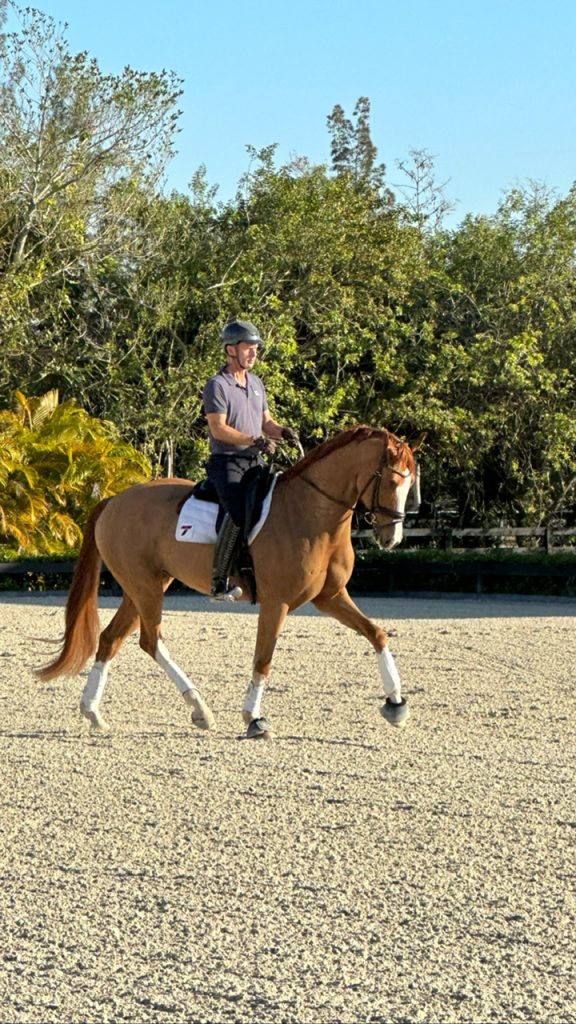
Photo by Courtesy of Team Irwin Dressage
“When the kidneys are under stress and are therefore failing to do their job properly, what you need to do as an internal medicine specialist is provide the body with what is needed to reestablish that optimum equilibrium,” shared Dr. Marqués. “By doing this, you help the body to balance all the things that cannot be balanced by the kidneys until the kidneys heal.”
While at PBEC, staff worked to give Feine’s body the support it needed. He was hooked up to a catheter and given continuous intravenous isotonic polyionic fluids. Under the direction of Dr. Marqués, Feine’s blood and urine were checked regularly to ensure the fluid solution given had the correct components and was administered at the optimal rate. Pain management can be an important part of injury treatment, but in this case, non-steroidal anti-inflammatory drugs (NSAIDs) could not be used because they can induce more damage to the kidneys.

Photo by KTB Creative Group
“There are many types of fluids you can give to a horse,” noted Dr. Marqués. “The compositions vary depending on what the horse needs in each specific case to reestablish a delicate and precise concentration of substances in the blood and other body compartments. For example, if you see from testing that there is one electrolyte that is pretty low, then you provide a fluid with more of that electrolyte.”
Having a horse in the clinic can be nerve-wracking for any horse owner, even if it’s just for a few days. With the right veterinary support and clear discourse, it becomes much easier to be involved in the recovery and achieve the best possible outcome.
“The communication with Dr. Marqués was exceptional,” commented Tina. “He would call and text us throughout the day and update us on Feine and his health. We went to visit him as well, and the entire experience was very positive.”
After a few days of treatment, Feine regained renal function and was able to return home. Though he was on the right track, it was still important to be sure his body continued to heal.
“Dr. Marqués continued to check in on Feine to see how he was doing after he was discharged from the Clinic,” recalled Jaimey. “He came to our farm in Wellington to check him personally.”
It was soon time for the Irwins to return to Canada. In the lead-up to the trip, Tina and Jaimey discussed with their regular veterinarian and Dr. Marqués the best plan to get Feine home safely. Everyone wanted to be as cautious as possible to prevent dehydration or any additional stress that travel could pose to Feine’s body, so all transportation options and logistics were considered. Fortunately, by the time the trip came, Feine had clinically returned to normal and he shipped smoothly, arriving safely up north.
“We kept in close communication throughout the entire process,” said Dr. Marqués of Feine’s treatment and recovery. “Good communication is so important between referring veterinarians, veterinarians in the clinic, and clients. This is a good example of if you were to wait too long, maybe it’s too late to solve the problem. The Irwins were really keen to do whatever was needed, so we were successful.”
Feine went on to compete throughout the 2023 summer season with Jaimey in the irons, notching several first-place finishes, including impressive scores of 75.172% and 78.846% in training level competition. He’s back on track toward the exciting dressage career he was meant to have.If you or your veterinarian would like to learn more about Palm Beach Equine Clinic’s and how it can help your horse, make an appointment at 561-793-1599 or learn more at www.EquineClinic.com.
As Palm Beach Equine Clinic’s newly appointed Hospital Manager, Sarah Panico brings her love of horses and her past experiences of riding, competing, barn, and show management to PBEC. An avid horse lover since the age of seven, Panico became a working student as a young adult until she almost left the industry when she was 19.
“I was looking to change jobs and do something entirely different,” explained Panico. “My mom saw a job application for the hospital technician position at Palm Beach Equine Clinic on social media. I wasn’t going to apply for it, but she convinced me, and I’m forever grateful for that.”
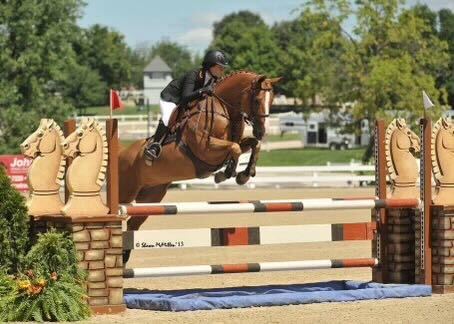
When she joined the team at Palm Beach Equine Clinic, located in Wellington, FL, Panico thought she wanted to become a veterinarian. However, she changed her mind after discovering her true passion while working as a veterinarian technician. She found that she enjoyed the hands-on role of being a hospital technician, which involved following treatment plans and taking care of the horses in the clinic’s care. Critical cases were especially appealing to her as she enjoyed the concentrated care each case required.
“When I first started working here, I thought I had a decent amount of knowledge about horses and their care,” commented Panico. “But working with the team of Veterinarians at PBEC, it has given me the opportunity to gain a wider variety of knowledge and experience. It inspires me to keep learning and growing. The Palm Beach Equine veterinarians thoroughly enjoy teaching just as much as you enjoy learning from them.”

Panico’s day-to-day tasks as Hospital Manager are much more extensive than when she was a hospital technician. Her job responsibilities involve overseeing the hospital, managing patients, training employees, and managing critical cases. She also updates and schedules the patients’ treatment plans, assists in prepping patients for surgery, coordinates admitting/discharging patients, and assists the doctors with procedures, morning rounds, and assessments.

Nine years later, Panico still enjoys coming to work every day. She loves taking care of her patients and being a part of their recovery process. She also credits her team and co-workers with making the management aspect of her role something she enjoys as well.
“We have a great team of dedicated people here,” said Panico.
When veterinarians work to diagnose illness or injury in a horse, they must rely on their knowledge, problem-solving skills, and the resources available to them. At Palm Beach Equine Clinic (PBEC), a new 2024 Canon Aquilion LB Exceed Dual Energy Computed Tomography (CT) scanner is making that process easier, faster, and more precise. Along with PBEC’s other imaging modalities, including radiographs, ultrasound, MRI, and nuclear scintigraphy, veterinarians can get a clear picture of what’s wrong, make a precise surgical plan if needed, and design comprehensive treatment plans. PBEC is the only facility in South Florida with a Canon Aquilion LB Exceed CT scanner, and it is available for referring veterinarians.
“It can be a life-saving technology,” said Dr. Karen Beste, a board-certified surgeon at PBEC and the head of the imaging team. “It can change outcomes for horses. In its first month of use, the new Canon CT scanner has already told us that a horse didn’t have the fractured leg that we initially thought. We were able to take the horse directly into surgery and save its life.”

The new CT scanner at PBEC is able to show detail that is not detectable on routine imaging modalities, providing soft tissue detail. In addition, it can help veterinarians scan areas of the equine body that were previously difficult or impossible to see, such as the pelvis, sacroiliac, hip joints, stifles, entire limbs, and the neck.
“The neck is a really difficult area to image,” said Dr. Beste. “Routine radiographs don’t provide 3D detail. We can add contrast for myelograms, which allows us to look for dynamic compressions in the spine. We can see detailed changes that may impact a horse’s ability to perform and be a safe horse to ride. We are able to get full neck CTs, all the way to thoracic vertebrae, even on really large horses. Because acquisition times of images are so fast, horses are under general anesthesia for a very short time, which is better for any horse but particularly for a neurologic horse.”
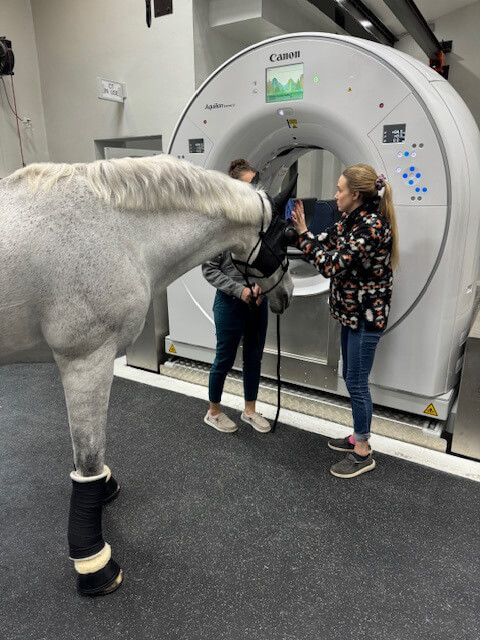
While PBEC’s Canon Aquilion LB Exceed CT scanner has incredible technology, it’s nothing without the experts to manage the scanning and read the scans, which include board-certified radiologists Dr. Sarah Puchalski and Dr. Stacie Aarsvold, who look at every scan.
“Images are viewed by world-renowned radiologists the moment we get them,” noted Dr. Beste. “The whole imaging team is well trained and has so much experience. In addition to that, some of the best surgeons in South Florida can be present during the scan. If needed, horses can be taken directly from the CT into surgery, where CT-guided surgeries are performed. It is especially helpful if a horse is already under general anesthesia because they can go right into surgery in one anesthetic episode. The CT can make a surgical approach more precise, and the surgeon is able to perform it more quickly. The surgeon knows exactly what they need to do and doesn’t have any guesswork.”
If you or your veterinarian would like to take the guesswork out of diagnosing your horse, reach out to the PBEC team today to learn more or make an appointment for a scan at 561-793-1599.
Wellington, FL – Palm Beach Equine Clinic is thrilled to announce the addition of a 2024 Canon Aquilion LB Exceed Dual Energy Computed Tomography (CT) scanner to its lineup of modern medical imaging modalities. Palm Beach Equine Clinic is currently the only facility in South Florida with a Canon Aquilion LB Exceed CT scanner, which is six times faster than other CT capabilities.
With increased speed, there is less motion and consequently a sharper and more accurate image. This specific CT scanner is also equipped with Dual Energy, which permits Palm Beach Equine Clinic veterinarians to visualize subchondral bone injury and edema. This CT scanner is also supplied with artificial intelligence to maximize the quality of the image.

“There is no other CT in South Florida that can compete with the quality of the images produced by our scanner,” stated Dr. Scott Swerdlin, President of Palm Beach Equine Clinic. “Our hospital takes enormous pride in being the foremost world-class facility equipped with the industry’s most advanced technology for the diagnosis, treatment, and rehabilitation of your valued sport horse.”
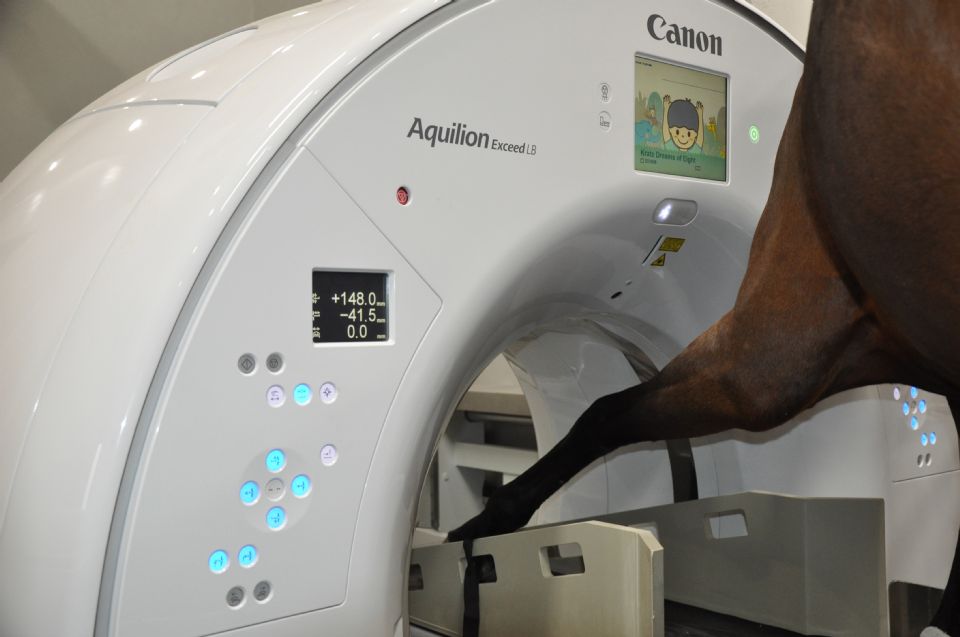
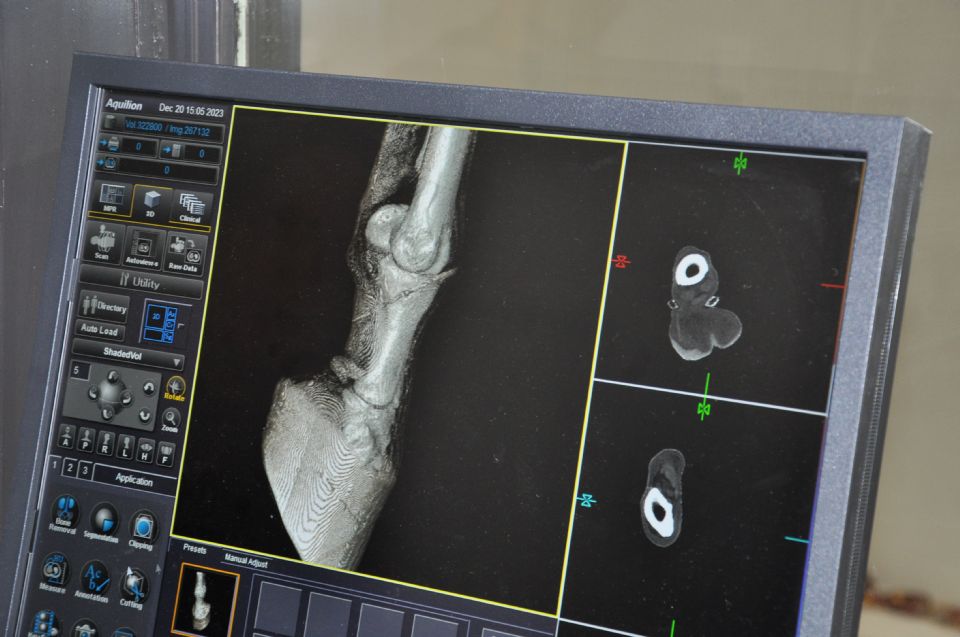
CT technology utilizes electron beams to digitally identify structures on multiple planes, from multiple angles, allowing veterinarians to examine structures, such as the skull, spine, and distal limbs, on an intricate level.
The Canon Aquilion LB Exceed Dual Energy CT scanner combines extremely detailed image quality with the versatility needed for advanced veterinary medicine. The technology of this CT scanner allows remarkable imaging of bone and soft tissue structures at the highest resolution. The entire scanning unit of the Canon Aquilion LB Exceed Dual Energy CT sits on a gantry, which moves in all directions around the patient. The system can be elevated to scan the head and neck or lowered to scan the distal limbs of a standing horse. The CT scanner’s large bore, or opening of the CT scanner, size of 90cm allowed Palm Beach Equine Clinic veterinarians to produce a CT image of an equine pelvis for the first time.
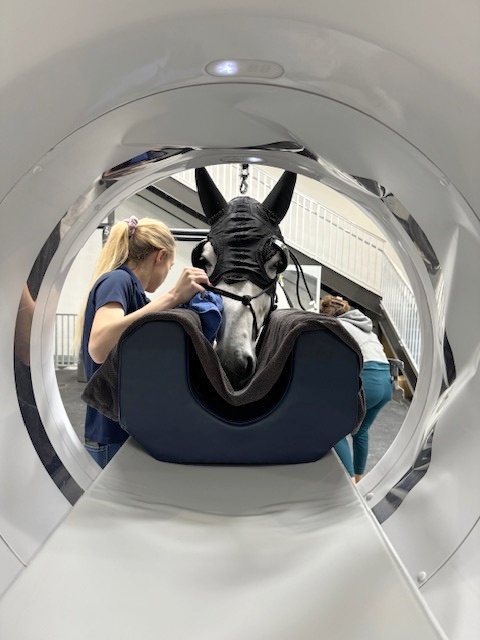
“We are very excited to bring this world-class technology to Wellington and provide an incomparable service to horse owners in the area,” said Dr. Swerdlin. “Our new Canon Aquilion LB Exceed Dual Energy CT scanner will allow us to more accurately diagnose injuries in every part of a horse’s body, while also making the process easy and extremely quick, literally in a matter of seconds. The imaging team consists of a talented group of imaging-specific technicians as well as veterinarians which include Board-Certified Radiologists Drs. Sarah Puchalski and Stacie Aarsvold. Our imaging team is headed by Dr. Karen Beste, Board-Certified Surgeon, who will coordinate and communicate with all referring veterinarians.”
The modern medical imaging modalities at Palm Beach Equine Clinic, including CT, magnetic resonance imaging (MRI), digital radiographs, and nuclear scintigraphy (bone scan), permit veterinarians to make a timely diagnosis and are available for all equine patients, even if their primary veterinarian is not at Palm Beach Equine Clinic.

“I would like to personally extend an invitation to all Wellington veterinarians to visit Palm Beach Equine Clinic to learn more about what the Canon Aquilion LB Exceed Dual Energy CT scanner has to offer in their practice,” concluded Dr. Swerdlin.
Palm Beach Equine Clinic has provided the highest quality of equine health care for more than 40 years. With cutting-edge technology and great compassion for the horses, Palm Beach Equine Clinic is committed to providing exceptional service for both patients and owners. For more information on what Palm Beach Equine Clinic has to offer, visit www.EquineClinic.com, or call 561-793-1599.
All photos courtesy of Palm Beach Equine Clinic
About Palm Beach Equine Clinic
Palm Beach Equine Clinic is a full-service medical facility offering care 24 hours a day, 365 days a year. Equipped with a surgical center, advanced diagnostic imaging units, laboratory, pharmacy, reproductive station and breeding shed, recovery stalls, and isolation unit, Palm Beach Equine Clinic has the necessary tools for diagnosing and treating a variety of cases. Palm Beach Equine Clinic is ideally based in the international hub of elite equestrian competition, Wellington, Florida, and is within riding distance of the Winter Equestrian Festival, Global Dressage Festival, and National Polo Center. Palm Beach Equine Clinic is proud to care for all horses, whether they are an Olympic-level athlete, trusted show pony, or reliable trail horse.
Dr. Santiago Demierre has been an integral part of the Palm Beach Equine Clinic team of veterinarians for the past 10 years. Dr. Demierre primarily focuses on equine performance medicine and is passionate about the prevention and treatment of lameness in sport horses. Keep reading to learn more about Dr. Demierre’s backgroundand his role at Palm Beach Equine Clinic.
Dr. Demierre was raised in San Antonio de Areco, a small town in the countryside outside Buenos Aires, Argentina. He grew up immersed in the equine industry as his father was a racehorse breeder and trainer. Dr. Demierre completed his veterinary medicine degree from the Universidad de Buenos Aires in 2012.
He began his career at Palm Beach Equine Clinic as an intern and then went on to become an ambulatory veterinarian before focusing on sport horse medicine. Dr. Demierre currently cares for some of the country’s top polo, jumper, and dressage horses.
“We have worked with Dr. Demierre several times now, and we love his determination and patience when it comes to the welfare of our horses,” said U.S. show jumping athlete Ali Boone. “He is the first one there in any urgent care we have needed, and he not only puts the animals’ needs above all else, but he also takes the time to explain and talk through any diagnosis and situation that needs special attention.”
At Palm Beach Equine Clinic, Dr. Demierre enjoys being surrounded by a diverse group of exceptional veterinarians who are always available to advise on a case. Dr. Jorge Gomez, Dr. Robert Brusie, and Dr. Scott Swerdlin have all played influential roles in Dr. Demierre’s career by providing guidance on managing cases and clients.
In his free time, Dr. Demierre stays busy riding polo ponies, fishing, hunting, hiking, and enjoying time outdoors.

The $25,000 Palm Beach Equine Clinic Grand Prix took place on Sunday, September 3, 2023, at Equestrian Village in Wellington, FL. The class served as the highlight event to close out the ESP Labor Day show. Sharn Wordley (NZL) and Valentine Car, owned by Fernando Cardenas, bested a field of 27 entries to take home the top prize.
Héctor Loyola (PUR) designed a technical track for the starting field of horse-and-rider combinations. Wordley and Valentine Car went toward the end of the order and produced a fault-free effort. In the end, 10 pairs managed a clear first round to advance to the jump-off.
“I thought the course was great,” shared Wordley. “The time was a bit fast for younger horses, but there were already 10 clear, and if the time had been slower there would have been 13 or 14 in the jump-off. For riders, where there’s a tight time on the first round, that’s where you must make your best judgment as to the pace you feel that your own horse is comfortable with.”
Wordley and Valentine Car were the second to last pair to return for the jump-off. The duo stopped the clock at 41.798 seconds to take first place. Wordley has been partnered with Valentine Car for the past two years, and they have earned many top placings together.
“He’s very quick-footed,” said Wordley of the 14-year-old Warmblood gelding. “Even in a fast jump-off like the one today it’s hard to beat him. He just skims over the jumps. I think we’ll do one more of these shows this summer, and then we’ll start doing FEI classes in the fall. The shows here are great for younger and older horses to help prepare them for bigger classes, so I want to bring them down here once more this year.”
Gabriel de Matos Machado (BRA) and Evabellie W, owned by Emily Wood, claimed second place with a time of 42.866 seconds. Dylan Daly (IRL) and Cinderella Z, owned by Jacqueline Steffens Daly, secured third place after stopping the clock at 44.280
seconds.
Palm Beach Equine Clinic is the Official Veterinarian of the Wellington International Summer Series in Wellington, FL. Veterinarians are available on-site to provide exceptional care to competing horses as well as those in the surrounding Wellington area. View results, live stream replays, and more at WellingtonInternational.com. For more information about Palm Beach Equine Clinic, visit EquineClinic.com.

Photo by Wellington International/Cassidy Klein
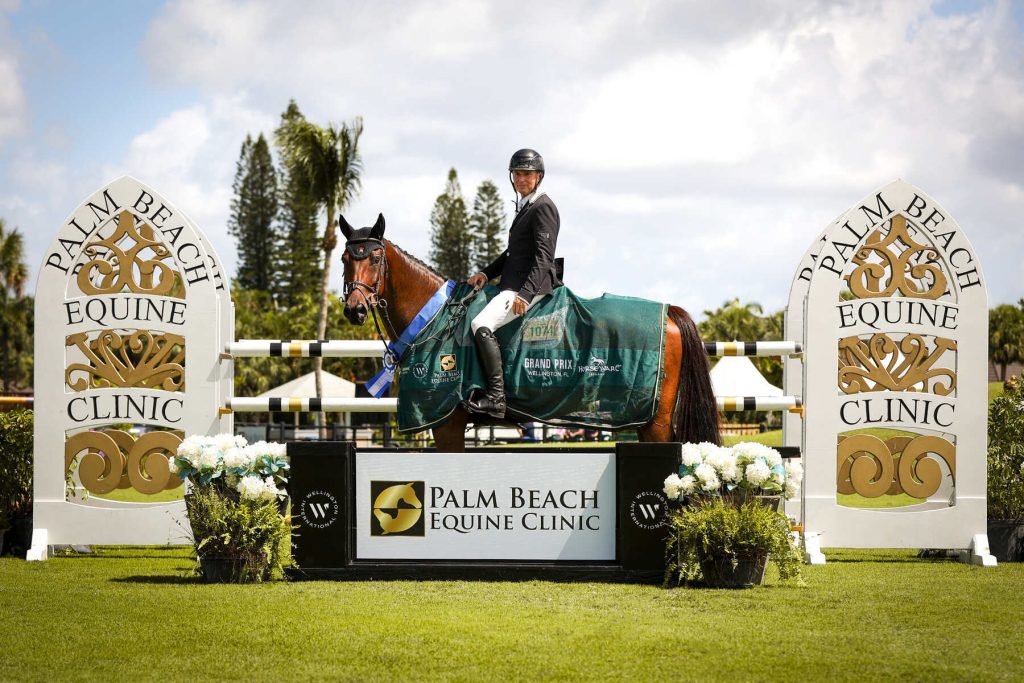
Palm Beach Equine Clinic Grand Prix.
Photo by Wellington International/Cassidy Klein
As elevated temperatures continue to prevail throughout the country, it is important that horse owners never underestimate how heat and humidity can affect equines. Even during the winter months, it is crucial to monitor how your horse is reacting to variations in temperature, especially when traveling to and from or relocating to Florida and other southern regions for the season.
Many problems can arise when temperatures climb, so as a starting point horse owners should pay attention to the amount of sweat their horse is producing. Anhidrosis, or the inability to sweat normally, can be a common challenge, particularly in hot, humid climates.
“Anhidrosis can develop acutely but generally develops gradually,” explained Dr. Natalia Novoa of Palm Beach Equine Clinic. “Horses lose 65-70% of their body heat through sweating, so the inability to sweat can be a potentially dangerous condition for them.”

Photo by Jump Media
In addition to lack of sweat, signs of Anhidrosis can include increased respiratory rate, elevated body temperature, areas of hair loss, or dry and flaky skin.
There are several treatment options for Anhidrosis including supplements, lifestyle changes, and alternative medicine practices.
“Electrolyte supplements and access to salt blocks are important to replenish chloride, sodium, and potassium,” said Dr. Novoa. “A Vitamin E supplement can also be beneficial because it is an antioxidant that helps with the oxidative damage due to environmental heat stress.”
In addition to supplements, it is important to keep the horse in a shaded and well-ventilated area if possible. It can also be helpful to keep the horse’s body clipped during the summer season.
Another treatment option is adding one serving of dark beer a day to the horse’s feed. The alcohol in beer is a vasodilator so it helps open capillaries allowing heat to pass through more rapidly to stimulate sweat.
Alternative medicine therapies such as acupuncture can also help decrease symptoms of Anhidrosis. “Acupuncture is very effective at clearing heat,” explained Dr. Novoa. “The normal functions of sweat glands and sweating are regulated by the heart, the lungs, and the triple heater. Heat and humidity can block the Qi flow of those meridians, which are pathways connecting acupuncture points, leading to Anhidrosis.



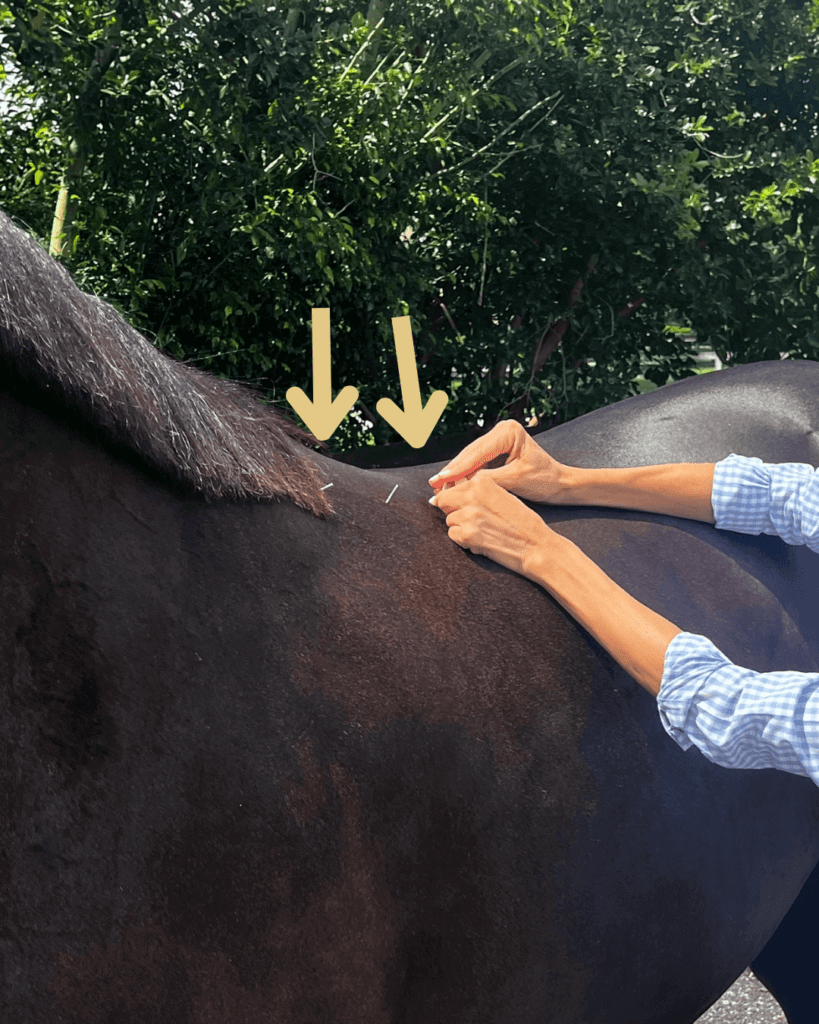



Furst Filou, owned by Maura Weis, demonstrating acupuncture points for Anhidrosis.
Photo courtesy of Dr. Natalia Novoa
“Acupuncture treatment strategies are designed to clear the summer heat, nourish the Yin, and promote body fluids,” continued Dr. Novoa. “Opening up certain points where the heat tends to collect will help release neurotransmitters that affect the flow of blood and lymph.”
According to Dr. Novoa, there are three areas to work on during the acupuncture process:
1. Heart: Helps with blood supply
2. Lung: Controls Wei Qi, which dominates the opening and closing mechanisms of the sweat glands
3. Triple Heater: Controls pathways of body fluids
“It requires a few acupuncture sessions to see a change,” said Dr. Novoa. “The process is different for each horse. It can also help with symptoms like exercise intolerance, tachypnea, and fatigue.”

New Xiang Ru San powder promotes heat and fluid disbursement through healthy sweating and clears Summer-Heat.
Photo courtesy of Dr. Natalia Novoa
Another alternative treatment option is Chinese herbal medicine. New Xiang Ru San powder has proven to be a clinically effective aid for non-sweaters as it promotes heat and fluid disbursement through healthy sweating and clears Summer-Heat. New Xiang Ru San is a blend of the Chinese herbs Bian Dou (hyacinth bean), Xiang Ru (mosla), Hou Po (magnolia bark), Lian Qiao (forsythia), and Jin Yin Hua (honeysuckle flower). Bian Dou eliminates Damp, Xiang Ru clears Summer-Heat, Hou Po moves Qi and eliminates Damp, Lian Qiao clears Heat and opens the Exterior, and Jin Yin Hua clears Heat Toxin, detoxifies, and releases Exterior.
Overall, it is important to manage a horse with Anhidrosis carefully. In addition to considering the techniques described earlier, try to exercise them when temperatures are lower in the early morning or late evening. Also, make sure to allow plenty of cool-down time after exercise and monitor their respiration rate.
Anhidrosis is one of many significant issues to be aware of during temperature increases. Contact Palm Beach Equine Clinic to learn more about precautions that can be taken to keep horses happy and healthy throughout the summer season.
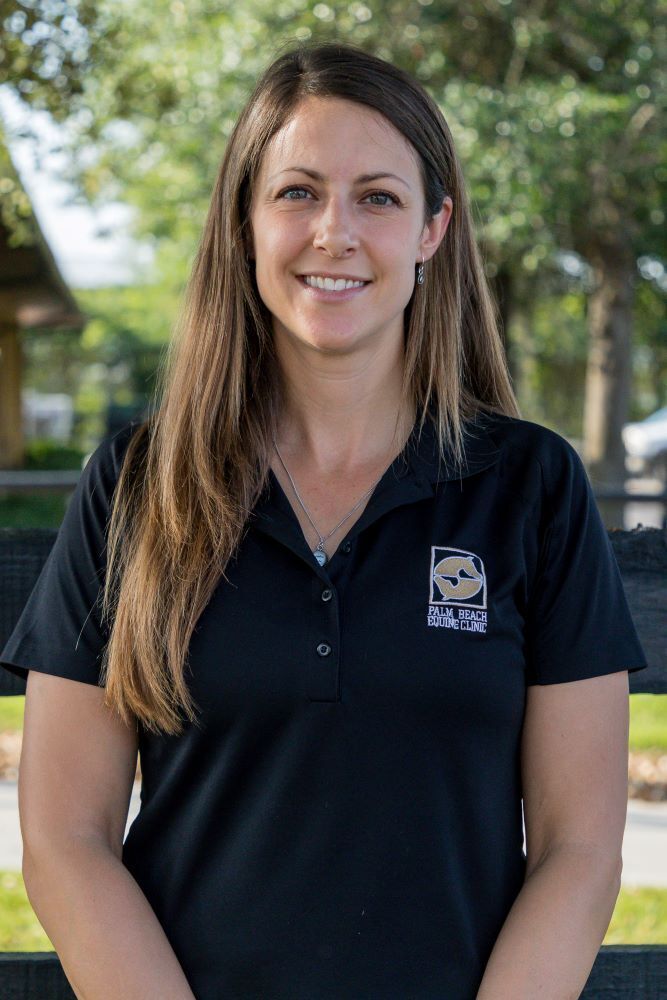
Where did you grow up and what is your background with horses?
I’m Canadian, and I grew up in Winnipeg, Manitoba. Even though I lived in the city I was obsessed with horses from a young age and begged my mom for riding lessons. When I was 17 years old I started grooming horses for the polo circuit in Winnipeg and the obsession continued from there.
When and why did you decide to become a veterinarian?
I wasn’t sure what to do after high school, and becoming a veterinarian had always been a possibility but I couldn’t decide. I took a year off and went backpacking in Australia. During that time, I worked on a mango farm one and of the dogs got into a scrap with another dog. He was cut up so I took the first aid kit and doctored his wounds. That’s when I decided becoming a veterinarian was the way to go. I called my mom the same night and told her, and she was more than a little relieved.
Who has been the biggest influence in your life or career? What did they teach you?
The biggest influence in my life is my mom. She has taught me too many things to count. At the top of that list is to work hard in whatever you do. She taught me to always put forth your best effort, always leave a place better than how you found it, and always be kind and respectful to whomever you meet.
The biggest influence in my career is Dr. Jorge Gomez. He also believes in the importance of hard work, and he has helped me learn how to run a business. He has instilled in me the value of doing a good, thorough job and maintaining a high standard of practice.
What do you enjoy most about working with performance horses?
What I enjoy most about working on performance horses is a simple answer: watching a horse you care for succeed and perform well. The horses we work on are incredible athletes, and it’s a privilege to be a part of the team that cares for them.
What do you enjoy most about working at Palm Beach Equine Clinic?
What I enjoy the most about working at Palm Beach Equine Clinic is having so many specialists and vets with experience available to help with complicated cases. There is always someone to ask or give advice, and surrounding yourself with people like that ensures you are always providing the best standard of care possible.
What is something interesting that people may not know about you?
Scuba diving is my absolute favorite non-equine activity. In a different life if I never was a horse-crazy person I would have been a marine biologist and found a job that included scuba diving.
Palm Beach Equine Clinic served as Official Treating Veterinarian during the Longines Global Champions Tour (LGCT) of Miami Beach in Miami, FL, from Sunday, April 9 through Sunday, April 16, 2023. Dr. Christopher Elliott was on-site daily during this international competition. Keep reading to learn about Dr. Elliott’s week while at this one-of-a-kind venue.

Photo courtesy of Dr. Christopher Elliott
Arrival of International Horses – Sunday, April 9, 2023
The first day started at the airport with the arrival of the international horses. During this process, Palm Beach Equine Clinic veterinarians worked alongside the government veterinarians from the United States Department of Agriculture (USDA) to make sure all the horses arriving were happy and healthy. While the horses were still on the airport tarmac, a team of government and local veterinarians performed the first two steps of the arrival process. First, we checked and cross-referenced microchips to confirm each horse’s identity. Then we took blood samples from each horse.
All horses entering the U.S. had to be in quarantine for 48 hours under USDA government control. There are very strict veterinary protocols to ensure no diseases are inadvertently introduced into the country. Upon arrival in quarantine, horses were inspected by the USDA veterinarians for any evidence of illness or injury. All the horses in quarantine had their temperature taken and were inspected for any ectoparasites.
After being strictly monitored, including twice-daily veterinary inspections and temperature checks, the international horses were released from strict quarantine into the controlled competition environment. The international horses were housed in separate stables from domestic American horses. They were also kept separate in the training arena. Throughout the duration of the competition, all international horses were strictly monitored by both government veterinarians and the official veterinarians of the competition. All of these procedures are designed to prevent the inadvertent introduction of foreign or infectious diseases and protect the U.S. horse population. Fortunately, all of the international horses that arrived in Miami had no health concerns.
Arrival Examination Day for National Horses, Horse Inspection, and Arena Familiarization – Thursday, April 13, 2023
I began Thursday at the competition venue with the arrival examination for all FEI horses who were already in the United States.
We inspected each national horse for any obvious signs of illness or injury, and then we scanned their microchip. Our microchip readers are linked via Bluetooth to our phones so when we scan a microchip, we can see all of the horse’s FEI details within the veterinary side of the FEI HorseApp. The app gives us all the information we need to know about the horse and whether all of the documentation was done correctly. Before the horses arrived at the competition venue, the owners and riders were required to complete documentation on the FEI HorseApp including the self-declaration of health stating that their horses were healthy prior to arriving at the venue. They also had to take their horses’ temperatures in the morning and evening for three days prior to arrival at the FEI venue and record it in the app.

Photo courtesy of Dr. Christopher Elliott
After we checked that information, we looked at the horse’s passport to make sure it was up to date with all of its vaccinations. We checked that the last Equine Influenza vaccination was within six months and 21 days of arrival at the horse show. We also asked the rider or groom to take the horse’s temperature right then and there to make sure it is good.
Once the horses were all checked in, the horse inspection for national and international horses got underway. I supervised all of the national and international horses going through horse inspection. As the Official Treating Veterinarian, I worked with the veterinary delegate who traveled in from Italy since LGCT has a very international team. During the horse inspection, my role was to make sure everything ran smoothly. I was also there to examine any horses that might not have been successful through the jog but fortunately they all passed the jog. After the horse inspection, it was time for arena familiarization and schooling where I stood ringside to make sure all horses stayed injury free.
Competition Days – Friday, April 14 through Sunday, April 16, 2023
The competition days started really early. Thankfully at this event it’s not too bad because you get to see the sunrise over the ocean. The warm-up and schooling arena opened at 5:30 a.m., so I was on-call by the schooling arena then to make sure all horses were happy and healthy.

Photo courtesy of Dr. Christopher Elliott
Once the competition began, I was right there at the in-gate with the emergency veterinary kit bag just in case I needed to attend to any horses in the ring. Fortunately we only had to look at a couple of very minor things throughout the competition.
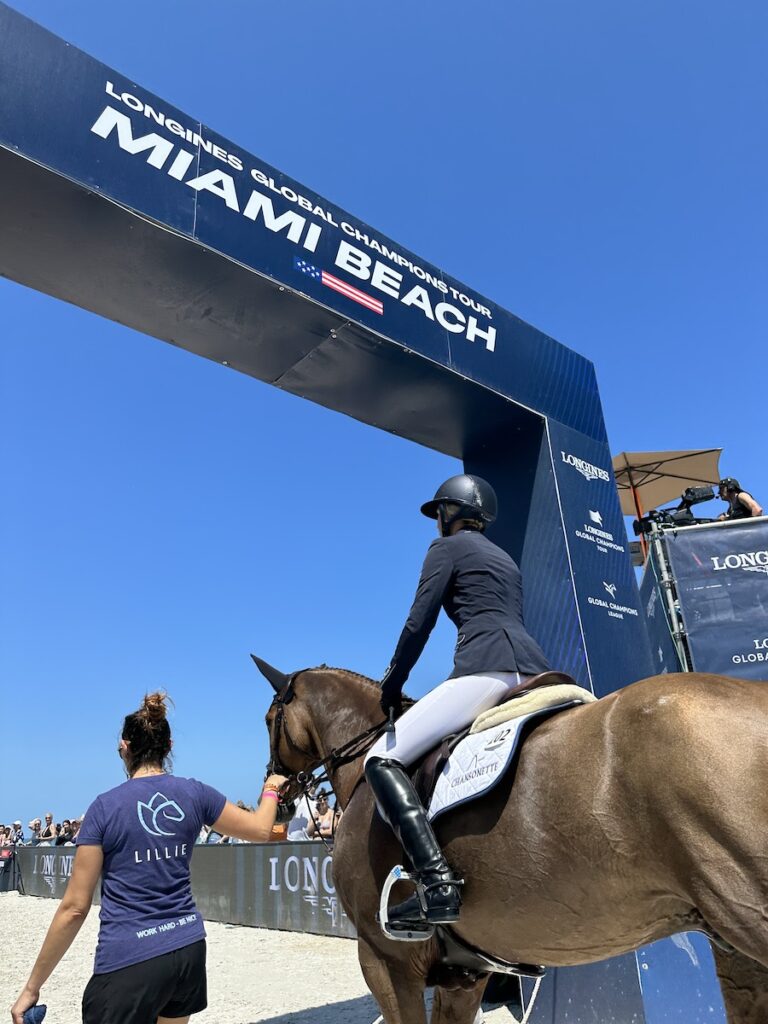
Photo courtesy of Dr. Christopher Elliott
In the afternoons my role changed to supporting the horses’ recovery from the competition day. Dr. Sarah Allendorf from Palm Beach Equine Clinic came down from Wellington each afternoon to help. Between the two of us, we examined horses after they competed and advised riders and grooms on how best to look after them in preparation for the next day. We administered some supportive therapies within the rules of the FEI. On Saturday it was very hot and humid, so we administered some fluids to help the horses recover and ensure they were fit and healthy for the following day.
On Sunday afternoon while the final CSI2* competition was taking place, Dr. Allendorf and I prepared the international horses for their next journey. We made sure the horses were healthy and ready to travel. We escorted them to the airport where they went on to the next LGCT event – Mexico City!
On Sunday afternoon while the final CSI2* competition was taking place, Dr. Allendorf and I prepared the international horses for their next journey. We made sure the horses were healthy and ready to travel. We escorted them to the airport where they went on to the next LGCT event – Mexico City!
As winter winds down and everyone looks ahead to the exciting spring and summer show season, there are preparations that can be taken in your horse’s care to ensure you get off on the right hoof. Close communication with your veterinarian can help you stay on track and ensure everything is properly addressed. Vaccinations, deworming, therapies and treatments, as well as shipping care and paperwork are all important to think about. At Palm Beach Equine Clinic in Wellington, FL, Dr. Elizabeth Barrett works with her clients to stay organized for the upcoming show season.
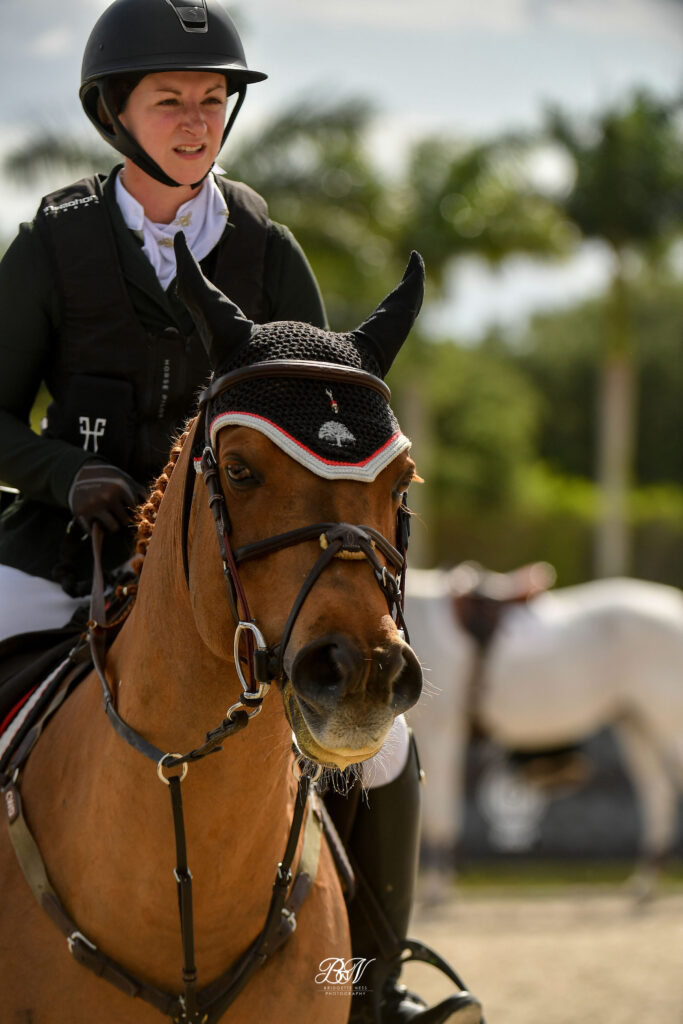
Photo by Bridget Ness Photography
Vaccinations
Horses are generally vaccinated twice per year in the fall and spring. If you and your horse are traveling to a new area for the spring and summer season, it is important to think about the requirements of that area or diseases more commonly found there. As an example, Dr. Barrett notes that the Potomac Fever vaccine is not always administered in Florida but can be important for horses traveling to the northeastern part of the country.
Vaccinations also need to be administered with enough time prior to shipping or competing, making scheduling considerations more crucial. Dr. Barrett maintains consistent communication with her clients to find the most optimal day to vaccinate such that it coincides with the horse’s existing schedule. While horse owners and barn managers help organize timing, Dr. Barrett stays prepared on her end by counting her patients and ordering enough vaccines for them.
“The responsibility goes both ways,” said Dr. Barrett. “Usually, the farm manager will let me know that they have some time off from showing, so it’s a good time for spring vaccines. I might also remind them that it’s getting to be time to do that so they can work it into their schedules.”
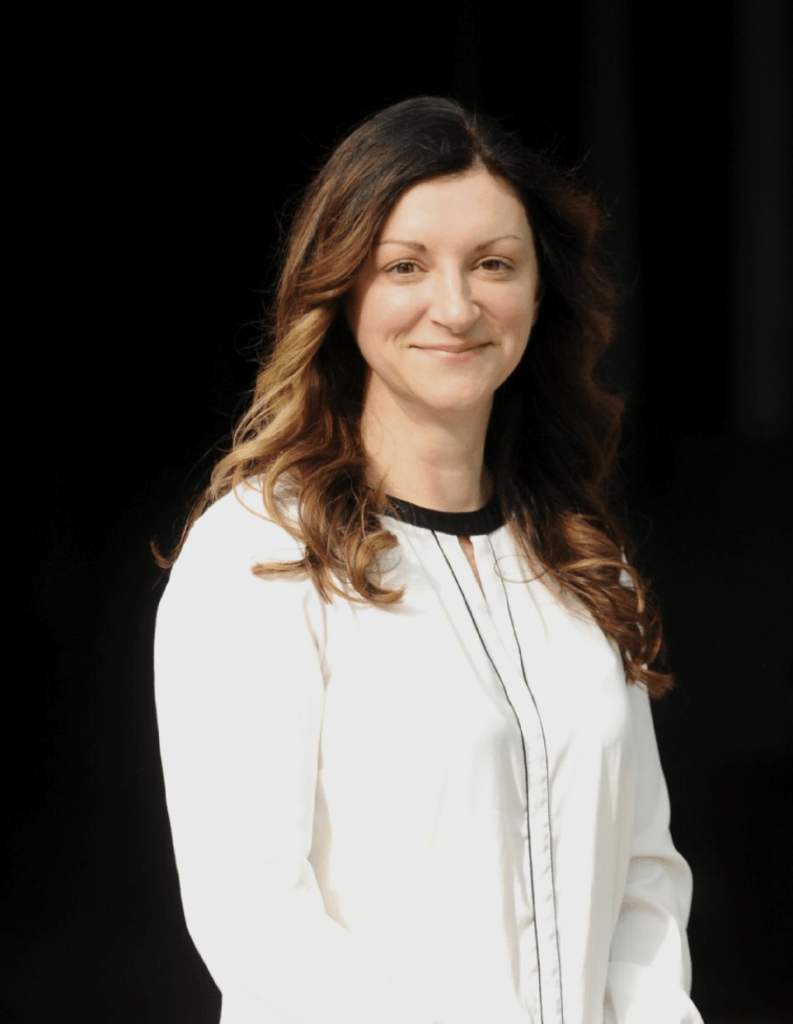
Photo courtesy of Dr. Elizabeth Barrett
Deworming
Springtime is also a good opportunity to deworm. When horses have traveled from one area to another, it is more crucial. While Dr. Barrett recommends worming twice annually, she explained that it is necessary to pay attention to each individual horse. Examining the horse and knowing the horse’s situation should guide the worming program. Horses that show clinical signs of worms, such as issues with weight and coat, should have a fecal egg count performed no matter what time of year.
Therapies and Treatments
Many horses are completing busy winter show schedules and heading into a break before ramping back up again. This downtime is a great window of opportunity to help address any issues that may have emerged. Dr. Barrett suggests having your horse treated at the beginning of a break to allow more time for the treatment to settle in. Some joint injections and therapies require longer recovery times, so that needs to be planned accordingly.
“After the winter show circuit, I go over all the horses completely to see if there are any issues,” detailed Dr. Barrett. “If there is any lameness or any maintenance we need to do, we try to time it so that the horse has at least a small break before they ship to their next show. Sometimes the horse just needs downtime, and during the spring is often the time they can get that rest. It’s also a good time for different training routines, such as a water treadmill or hill work to change up the program a little bit.”
Shipping
Spring and summer showing and shipping go hand in hand. Remembering all the paperwork that needs to be completed ahead of time is key to avoiding a last-minute scramble. Health certificates and Coggins papers are necessary documents for horses to travel both domestically and internationally. Dr. Barrett notes that it takes at least two days for a vet to complete this paperwork for national travel, so it is essential to keep that in mind when arranging an interstate trip. International travel health certificates take longer to prepare and have more requirements, necessitating additional forethought.
Once the logistics are handled, the horse must be physically prepared to ship. The longer the trip, the more stress it can put on the horse. Even trips as few as three hours can increase health concerns. Stomach ulcers are always a risk, so Dr. Barrett suggests administering preventative omeprazole paste to help keep your horse comfortable. Again, Dr. Barrett stresses that each horse needs to be considered individually, so a horse more prone to ulceration might also benefit from sucralfate when shipping.
“I would scope the stomach of any horse we are worried about that is clinically showing signs that they could have ulcers,” shared Dr. Barrett. “When they ship, it helps to try to feed them a little bit at a time with a steady supply of hay throughout the trip so that their stomach is full.”
Shipping fever and colic are other common issues. Taking your horse’s temperature and monitoring their behavior can help detect the problem sooner. Dr. Barrett also offers a couple of tricks to keep your horse hydrated and feeling comfortable in travel. Feeding a wet mash with mineral oil before the journey helps prevent impaction. Getting your horse accustomed to an electrolyte-flavored water beforehand allows you to produce the same familiar flavor on the road to encourage even the most stubborn drinker.
Additional precautions can be made to prevent other injuries. Considering the horse and weather will guide the best plan. For example, in warmer weather a horse that travels well might do better without wraps, but a horse that is more self-destructive could still need extra protection. Certain halters can cause rubs in warmer weather too. Dr. Barrett cautions that injury can also be caused by a travel buddy.
“It is really important to pay attention to what horses are next to each other,” emphasized Dr. Barrett. “I’ve seen plenty of injuries where one horse is picking on another and causing trouble. I’ve seen more injuries from that than self-inflicted horse wounds, but both can happen. You have to be careful.”
It helps to have cameras on the horses during longer trips to ensure there are no issues. Since the driver usually stops for gas every four hours or so, that is a good time to check on the horses and offer water. For trips of more than 10 hours, it can help to stop and unload the horses to give them a break. Many commercial shippers will drive directly, so in those cases, the health preparations you make are even more significant.
In all of your organization for spring, the most important thing is to stay in contact with your veterinarian. They will be able to inform your decisions, help with timing issues, and make the best possible plan for you and your horse.